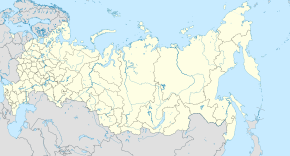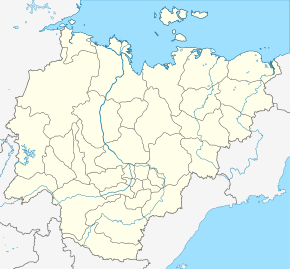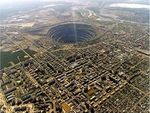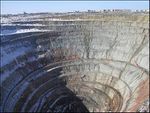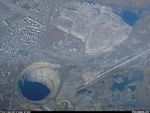منجم مير
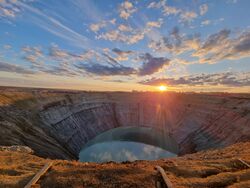 منجم مير في ياقوتيا | |
| الموقع | |
|---|---|
| الموقع | ميرني، جمهورية ساخا |
| Region | سيبيريا |
| البلد | روسيا |
| الإحداثيات | 62°31′45″N 113°59′36″E / 62.52917°N 113.99333°E |
| الانتاج | |
| المنتجات | ألماس |
| الانتاج | 10,000,000 قيراط (2,000 كيلوگرام) في السنة |
| السنة المالية | ع1960 |
| التاريخ | |
| اِفتـُتِح | 1957 |
| أُغلِق | 2004 |
| المالك | |
| الشركة | آلروسا |
| الموقع الإلكتروني | Link[dead link] |
| سنة الاستحواذ | 1992 |
منجم مير (روسية: кимберлитовая алмазная трубка «Мир» kimberlitovaya almaznaya trubka "Mir"؛ بالعربية: أنبوب ألماس كمبرليت "السلام")، ويسمى أيضاً منجم ميرني، هو منجم ماس مفتوح سابق، غير نشط حالياً، يقع في ميرني، شرق صربيا، روسيا. يبلغ عمق المنجم 525 متر (الرابع في العالم) ويبلغ قطره 1200 متر،[1] ويعتبر ثاني أعمق حفرة في العالم، بعد منجم بينگهام كانيون.
Open-pit mining began in 1957 and was discontinued in 2001. Since 2009, it has been active as an underground diamond mine.[2]
ويعتبر منجم مير واحداً من آيات الجمال والوحشية في الوقت نفسه. يبلغ عمقه 525 متر تحت سطح الأرض. وكذلك فإنه من المحظور الطيران فوق ثقب الحفرة لمسافة 1200 متر حيث أن قوة الشفط لحفرة بهذا العمق تؤدي لحوداث لطائرات الهليكوبتر.
الاكتشاف
The diamond-bearing deposits were discovered on June 13, 1955, by Soviet geologists Yuri Khabardin, Ekaterina Elagina and Viktor Avdeenko during the large Amakinsky Expedition in Yakut ASSR. They found traces of the volcanic rock kimberlite, which is usually associated with diamonds. This finding was the second success in the search for kimberlite in Russia, after numerous failed expeditions of the 1940s and 1950s. (The first was Zarnitsa mine, 1954.) For this discovery, in 1957, Khabardin was given the Lenin Prize,[3] one of the highest awards in the Soviet Union.[4][5]
التطوير
The development of the mine started in 1957, in extremely harsh climate conditions. Seven months of winter per year froze the ground, making it hard to mine. During the brief summer months, the ground turned to slush. Buildings had to be raised on piles, so that they would not sink from their warmth melting the permafrost. The main processing plant had to be built on better ground, found 20 km (12 mi) away from the mine. The winter temperatures were so low that car tires and steel would shatter and oil would freeze. During the winter, workers used jet engines to thaw and dig out the permafrost or blasted it with dynamite to get access to the underlying kimberlite. The entire mine had to be covered at night to prevent the machinery from freezing.[6][7]
In the 1960s, the mine was producing 10,000,000 carats (2,000 kg; 4,400 lb) of diamond per year, of which a relatively high fraction (20%) were of gem quality.[6] The upper layers of the mine (down to 340 m (1,120 ft)) had very high diamond contents of four carats (0.80 g) per tonne of ore, with a relatively high ratio of gems to industrial stones. The yield decreased to about 2 carats (0.40 g) per tonne and the production rate slowed to 2,000,000 carats (400 kg; 880 lb) per year near the pit bottom. The largest diamond of the mine was found on 23 December 1980; it weighed 342.5 carats (68.50 g) and was named "26th Congress of the Communist Party of the Soviet Union" (روسية: XXVI съезд КПСС). The mine operation was interrupted in the 1990s at a depth of 340 m (1,120 ft) after the pit bottom became flooded, but resumed later.[8][9]
تدخل دي بيرز
العمليات
The Mir mine was the first developed and the largest diamond mine in the Soviet Union.[10] Its surface operation lasted 44 years, finally closing in June 2001.[9] After the collapse of the USSR in the 1990s, the mine was operated by the Sakha diamond company, which reported annual profits in excess of $600 million[مطلوب توضيح] from diamond sales.[11]
Later, the mine was operated by Alrosa, the largest diamond producing company in Russia, and employed 3,600 workers. It had long been anticipated that the recovery of diamonds by conventional surface mining would end. Therefore, in the 1970s, construction of a network of tunnels for underground diamond recovery began. By 1999, the project operated exclusively as an underground mine. In order to stabilize the abandoned surface main pit, its bottom was covered by a rubble layer 45 m (148 ft) thick.[1] After underground operations began, the project had a mine life estimate of 27 years, based on a drilling exploration program to a depth of 1,220 m (4,000 ft). Production ceased in 2001,[12] and the Mir mine closed in 2004.[13][14]
The mine was recommissioned in 2009, and is expected to remain operational for 50 more years.[2] The underground Mir mine flooded again in 2017, trapping over 140 miners, all but 8 of whom were rescued. [15][16]
انظر أيضاً
معرض الصور
المصادر
- ^ أ ب "Mirninsky GOK" (in Russian). Retrieved 2009-08-08.
{{cite news}}: CS1 maint: unrecognized language (link) English version - ^ أ ب "Underground Mine of Mir Commissioned". Alrosa. Retrieved 28 August 2017.
- ^ Анастасия Литвинова (18 Feb 2021). "Intrigues of diamond discoverers, or who was the first to find the "Mir"". forpost-sz.ru.
- ^ Первооткрывателю трубки "Мир" Екатерине Елагиной исполняется 80 лет (in Russian).
{{cite news}}: CS1 maint: unrecognized language (link) - ^ Город Мирный. Official site of town Mirny (in russian). Archived from the original on 2009-06-10. Retrieved 2009-08-08.
{{cite web}}: CS1 maint: unrecognized language (link) - ^ أ ب "A Brief History of the World's Largest Open Pit Diamond Mine". Archived from the original on 2013-01-01. Retrieved 2009-08-08.
- ^ E. J. Epstein (1982). "17 The Russians are coming". The diamond invention. Hutchinson. ISBN 0-09-147690-9.
- ^ "Именные алмазы (list of named diamond)" (in Russian). Archived from the original on 2012-07-20. Retrieved 2009-08-08.
{{cite web}}: CS1 maint: unrecognized language (link) English version - ^ أ ب Kogel, Jessica Elzea; Trivedi, Nikhil C.; Barker, James M.; Krukowski, Stanley T., eds. (2006). Industrial Minerals & Rocks: Commodities, Markets, and Uses (7th ed.). SME. p. 424. ISBN 0-87335-233-5.
- ^ "The Nature of Diamonds - Russia". American Museum of Natural History. Archived from the original on 2009-04-04. Retrieved 2009-08-08.
- ^ Tichotsky, John (2000). Russia's Diamond Colony: The Republic of Sakha. Psychology Press. p. 333. ISBN 90-5702-420-9.
- ^ "Abandoned Mir Diamond Mine in Russia". www.amusingplanet.com (in الإنجليزية). Retrieved 2021-07-20.
- ^ "Mirny Mine". MineDat. Retrieved 29 January 2017.
- ^ Michaud, David (Chrispine) (4 سبتمبر 2013). "Largest Mines in the World". Mining Examiner. 911 Metallurgist. Archived from the original on 9 March 2014.
- ^ "Rescue team forced to give up hunt for four missing diamond miners; search still on for four more". Retrieved 2021-06-14.
- ^ "Russia: Eight missing in flooded diamond mine". BBC News. 5 August 2017.
وصلات خارجية
- Pages using gadget WikiMiniAtlas
- CS1 uses الروسية-language script (ru)
- Short description is different from Wikidata
- Coordinates on Wikidata
- Articles with dead external links from June 2017
- Pages using infobox mine with unknown parameters
- Articles containing روسية-language text
- Pages using Lang-xx templates
- جميع الصفحات التي تحتاج تنظيف
- مقالات بالمعرفة تحتاج توضيح from December 2018
- مناجم ماس في روسيا
- اقتصاد الاتحاد السوڤيتي
- اقتصاد سيبريا
- العلوم والتكنولوجيا في الاتحاد السوڤيتي
- مناجم سطحية في روسيا
- Diatremes of Russia
